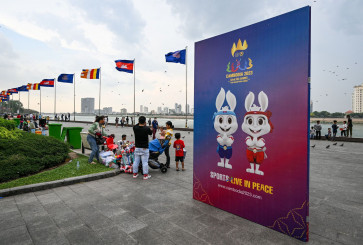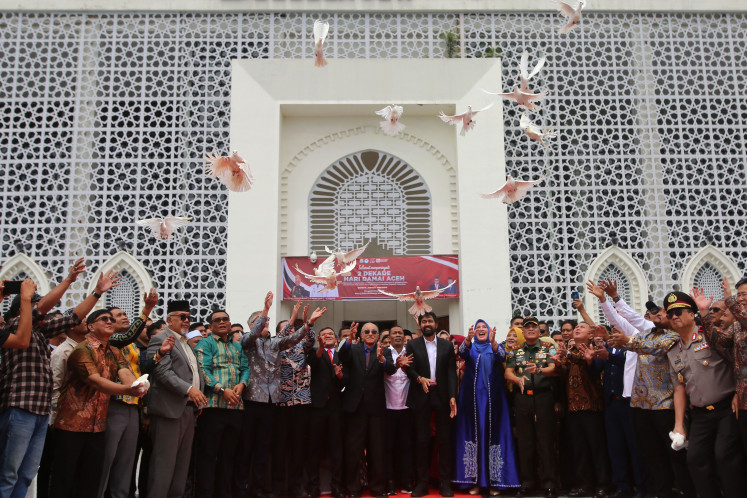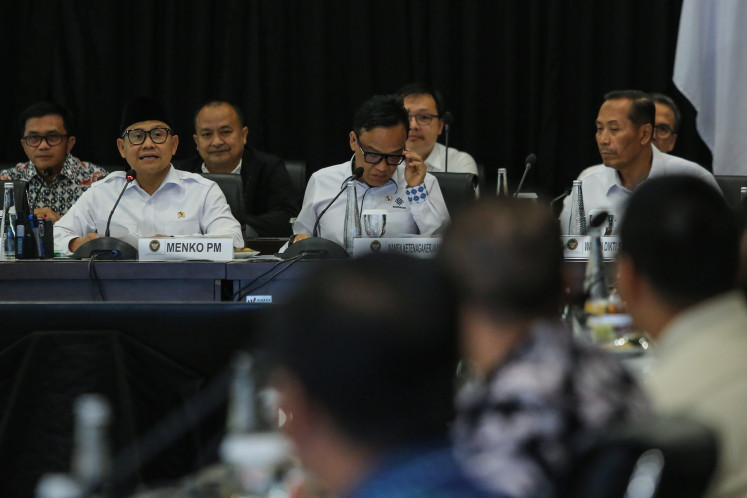Popular Reads
Top Results
Can't find what you're looking for?
View all search resultsPopular Reads
Top Results
Can't find what you're looking for?
View all search resultsMaking ‘lontar’ accessible
‘Lontar’ squad: The Hanacaraka Society’s key personages (from left to right): Dewa Ayu Carma Citrawati, Ida Bagus Komang Sudarma, Sugi Lanus, and Putu Ari Kurnia Budiasa
Change text size
Gift Premium Articles
to Anyone
‘Lontar’ squad: The Hanacaraka Society’s key personages (from left to right): Dewa Ayu Carma Citrawati, Ida Bagus Komang Sudarma, Sugi Lanus, and Putu Ari Kurnia Budiasa. The society aims at popularizing lontar among Balinese youth.
A leading winery and a society of lontar lovers team up to present an exquisite exhibition of the ancient manuscripts.
Lontar (palm-leaf manuscripts) and wine share one thing in common: Both are the mark of cultural refinement. For the Balinese, the ability to write and read lontar would place a person in a special, revered level of society. In the western world, the same can be said of a person who is able to create and appreciate exquisite wine.
A three-day exhibition this week is showcasing how close lontar and wine can cooperate in providing an “intoxicating” experience for the public.
To celebrate the unveiling of its commissioned lontar, Hatten Wines, the island’s first and premier Balinese winery, in collaboration with the Hanacaraka Society, a non-profit organization dedicated to the preservation and dissemination of lontar manuscripts, has organized a lontar exhibition, which is open for the public from Aug. 5 to 7, at the winery’s new building in Sanur.
It all started some five months ago. Maryse LaRocque, Hatten Wines’ marketing and business development advisor, was looking for a way to integrate Balinese Hinduism’s Tri Hita Karana into the interior of the new building when she met Sugi Lanus, a Balinese intellectual known for his research on lontar. Sugi is also the founder of the Hanacaraka Society.
Tri Hita Karana emphasizes the harmonious relationship between man with his fellow man, with nature and with God.

Ancient knowledge: Dewa Ayu Carma Citrawati reads a lontar, palm-leaf manuscripts that in ancient times served as the primary repository of Balinese knowledge and spirituality.
“The Private Dining Room with Gaggenau is a beautiful room in which I wanted to integrate all principals: the social aspect represented by a large table where we have communal meals with our guests, the integration of nature, which is symbolized by the plants in the atrium and also a very special fusion-frame where a vine from our vineyards comes out of a gilded frame,” she said.
She needed one last symbol, the one that represented the connection of humans with their creator. Sugi assisted Maryse in commissioning a lontar manuscript that would reflect that connection.
Etched by master lontar maker Ida Bagus Nyoman Buruan of Sidemen, Karangasem, the commissioned lontar features Arjuna Wiwaha, a classical long poem in Kawi depicting the struggle of Arjuna in searching for the ultimate weapon and his eventual encounter and communion with Lord Siwa, an experience that gives him a powerful spiritual realization.
The commission of a single lontar manuscript later evolved into a full-scale lontar exhibition.
“Hatten Wines is not just a wine company, it’s a Balinese winemaker, owned by a Balinese family and involving close to 250 families here: from pickers, to winery staff, delivery guys to accounting people, our team is touched by every bottle sold,” Maryse said.
“We in return, have a duty toward our industry to support the growers, and also we have a duty to our environment. We will have different events at our new building throughout the year, not only wine related. Supporting Balinese art is an important thing to do and we have a vehicle to do it,” she said.
The unveiling takes place on Thursday evening and the highlight will be a seminar presenting speakers from the Hanacaraka Society: Dewa Ayu Carma Citrawati, Ida Bagus Komang Sudarma and Putu Ari Kurnia Budiasa.
The exhibit features 35 cakepan (sets) of lontar from the collection of the Hanacaraka Society. The sets include lontar dealing with worldly matters, including pipil (land deeds) and tax reports from mid-19th century Buleleng, to ones describing rituals and offerings as well as Balinese Hinduism’s esoteric teachings.
Among the latter group are Aji Sunari Terus, a manual on meditation and prayer, and Kakawin Darma Sunia, a treatise on Siwaistic philosophy.
“The exhibited lontar span a diverse historical as well as literary period, from lontar on ritual mantras written in Sanskrit from the 13th century to literary works written in Old Javanese in the latter period up to the 19th century,” Sugi said.
“To a certain extent, it will provide a glimpse into the thematic richness and literary achievements of Balinese thinkers in the past,” he said.
The exhibited lontar also boast the esthetic exploration of their respective etchers as each region developed a unique, stylized way of writing Balinese script. For instance, lontar etched by Ida Bagus Nyoman Buruan displayed his visually stunning style of elongated scripts.
“This unique visual style is the reason why a good lontar manuscript is not only enjoyable to read but also very pleasing to behold,” Sugi said.
Visitors will also have an opportunity to set their eyes on several rare lontar, including Swamandala, a devotional text on the worship of Bhatari Ghori, the other name of Durga, who in Bali is popularly known as the most powerful goddess. The words and literary style used in Swamandala suggest that it was etched during the Gelgel period in the 15th century. The gist of the text, however, can be traced back to the reign of Jayasakti in the 12th century.

Exquisite pairing: Sets of lontar displayed next to bottles of wine produced by Hatten Wine, the island’s first and premier Balinese winery.
Other rare lontar include Usana Bali, a semi-mythological account of the arrival of the gods on the island, and Indarjaya, a text originating in Lombok, West Nusa Tenggara, and written in the Sasak tribe’s Jejawan script and Jawa Madya language. It narrates the story of a prince in search of love and spiritual enlightenment. He eventually receives teaching from a Muslim sage. The text contains the Shahada creed and the Basmala, which reflect the strong influence of Islam in the region.
“Then there is this lontar, Kidung Panji Malat Rasmi, which is very special because it was etched by a female writer. A female lontar etcher is, well, quite a rarity. It was etched in 1899 by high priestess Ida Pedanda Istri Pidada,” Sugi said.
He says it is somewhat ironic that people agree to preserve lontar manuscripts while at the same time the large majority of Balinese still treat lontar as sacred objects that must be kept hidden and locked away.
Sugi believes that making lontar manuscripts accessible to as many people as possible is the critical key in preserving and popularizing them.
“That’s why we agreed to hold this exhibit. By displaying lontar in this kind of setting, a familiar setting for many of our upper-income people, we hope to make lontar more accessible to modern Balinese youth and to shed that ‘sacred’ element that for decades has prevented Balinese youngsters from studying lontar,” he said.
He referred to the old belief that some lontar carry a curse that will inflict bodily harm or bring bad luck to individuals who read them without proper rituals and initiations.
Sugi founded the Hanacaraka Society in 2006 when he was living in Lombok after an increasing number of local people offered him lontar for purchase or safekeeping.
“I never believed that I had the right to own or claim an ownership over a lontar. Lontar should be public property. That’s why I established Hanacaraka. The lontar in the Hanacaraka collection is accessible to anybody wishing to learn about or make copies of them,” he said.
The Hanacaraka Society now has a collection of 112 lontar sets and 15 members, mostly young Balinese scholars.
— Photos by Anggara Mahendra










